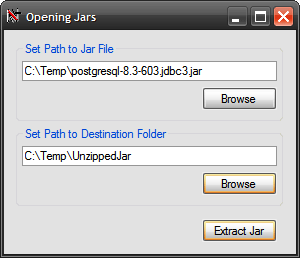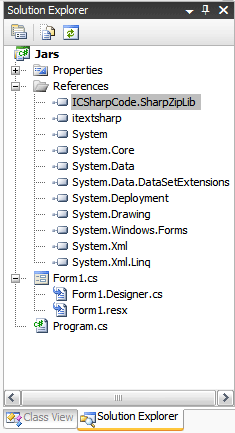Introduction
This article shall describe an approach that may be used to extract Jar files. Jars are merely files compressed using zip compression; the primary difference between a standard trash zip file and a jar file is that the jar file includes a manifest; also a true jar files can be run as an executable on a machine equipped with the java runtime. Jars typically contain java class files; if you have some need to extract a jar and view its contents, it is no more difficult to do that than it is to unzip a normal zip file.

Figure 1: Extracting a Jar File
Since the task of extracting a jar is really the same as it is to extract a zip file, the demo application will rely upon the free SharpZipLib libraries to perform the extraction; these libraries may be downloaded from this location: http://www.icsharpcode.net/OpenSource/SharpZipLib/
In addition to handling jar and zip files, the library also handles tar, gzip, and bzip2 compression.
The Solution
The solution contains a single project (Jars). The example is provided in the form of a single Windows Forms project; the project contains a single main form; the references are all in the default configuration with the exception being that the SharpZipLib DLL has been added (first item in the reference list). Having downloaded the DLL from the www.icsharpcode.net web, the download was installed into the local file system and was adding by using the "Add Reference" dialog's Browse option. All of the code necessary to drive the application is included in the main form's code file.

Figure 2: The Solution Explorer Showing the Project
The Code: Jars - Form1
The Jars project is a Windows Forms project containing a single form. All UI and code required by the project are contained in the single main form.
The only references added to the project, aside from the defaults, were those necessary to support the use of the SharpZipLib in the project. The imports, namespace, and class declarations are as follows:
using System.Collections;
using System.ComponentModel;
using System.Data;
using System.Drawing;
using System.Linq;
using System.Text;
using System.Windows.Forms;
using ICSharpCode.SharpZipLib.Zip;
using System.IO;
namespace Jars
{
public partial class Form1 : Form
{
After the class declaration, two private variables are declared; these variables are used to retain the path to the jar file and the path to the destination folder (where the jar will be unpacked).
// set variables to hold
// the paths to the jar file and
// to destination folder
private string mSourceJar;
private string mDestinationFolder;
the next block of code is the default constructor; nothing added there:
// default constructor
public Form1()
{
InitializeComponent();
}
The next block of code is used to perform the actual extraction. The ExtractJar function accepts two arguments, a string value defining the path to the jar file, and a string value defining the path to the destination folder (the location at which the jar will be unpacked). The method uses the SharpZipLibrary to extract the jar file. The code in annotated to describe the activity.
/// <summary>
/// Extracts the jar file to a specified
/// destination folder.
/// </summary>
private void ExtractJar(string pathToJar, string saveFolderPath)
{
string jarPath = pathToJar;
string savePath = saveFolderPath;
try
{
// verify the paths are set
if (!String.IsNullOrEmpty(jarPath) &&
!String.IsNullOrEmpty(saveFolderPath))
{
try
{
// use the SharpZip library FastZip
// utilities ExtractZip method to
// extract the jar file
FastZip fz = new FastZip();
fz.ExtractZip(jarPath, saveFolderPath, "");
// Success at this point, tell the user
// we are done.
MessageBox.Show("Jar File: " + jarPath + " was
extracted to " +
saveFolderPath, "Finished");
// open the destination folder in explorer
System.Diagnostics.Process.Start("explorer",
saveFolderPath);
}
catch (Exception ex)
{
// something went wrong
MessageBox.Show(ex.Message, "Extraction Error");
}
}
else
{
// the paths were not, tell the user to
// get with the program
StringBuilder sb = new StringBuilder();
sb.Append("Set the paths to both the jar file and " +
Environment.NewLine);
sb.Append("destination folder before attempting to " +
Environment.NewLine);
sb.Append("to extract a jar file.");
MessageBox.Show(sb.ToString(), "Unable to Extract");
}
}
catch (Exception ex)
{
// something else went wrong
MessageBox.Show(ex.Message, "Extraction Method Error");
}
}
The next block of code is used to set the path to the jar file. This button click event handler is used to display an open file dialog box; the user can use the dialog box to navigate to the location of the jar file and select it. The selected file name is used to set the mSourceJar string variable to the file path of the jar file; the file path is also displayed in the text box adjacent to the button.
/// <summary>
/// Set the path to the Jar File
/// </summary>
/// <param name="sender"></param>
/// <param name="e"></param>
private void btnSetJar_Click(object sender, EventArgs e)
{
try
{
OpenFileDialog1.Title = "Extract JAR";
OpenFileDialog1.DefaultExt = "jar";
OpenFileDialog1.Filter = "Jar Files|*.jar";
OpenFileDialog1.FileName = string.Empty;
OpenFileDialog1.Multiselect = false;
if (OpenFileDialog1.ShowDialog() == DialogResult.OK)
{
if (OpenFileDialog1.FileName == "")
{
return;
}
string strExt;
strExt =
System.IO.Path.GetExtension(OpenFileDialog1.FileName);
strExt = strExt.ToUpper();
if (strExt == ".JAR")
{
mSourceJar = OpenFileDialog1.FileName;
txtJarPath.Text = mSourceJar;
}
else
{
MessageBox.Show("The selected file is not a jar",
"File Error");
}
}
else
{
MessageBox.Show("File request cancelled by user.",
"Cancelled");
}
}
catch (Exception ex)
{
MessageBox.Show(ex.Message.ToString(), "Error");
}
}
/// <summary>
/// Set the path to the destination folder
/// </summary>
/// <param name="sender"></param>
/// <param name="e"></param>
private void btnDestinationFolder_Click(object sender, EventArgs e)
{
try
{
folderBrowserDialog1.ShowNewFolderButton = true;
DialogResult result = folderBrowserDialog1.ShowDialog();
if (result == DialogResult.OK)
{
mDestinationFolder = folderBrowserDialog1.SelectedPath;
txtDestinationFolder.Text = mDestinationFolder;
}
}
catch (Exception ex)
{
MessageBox.Show(ex.Message, "Error Setting Destination
Folder");
}
}